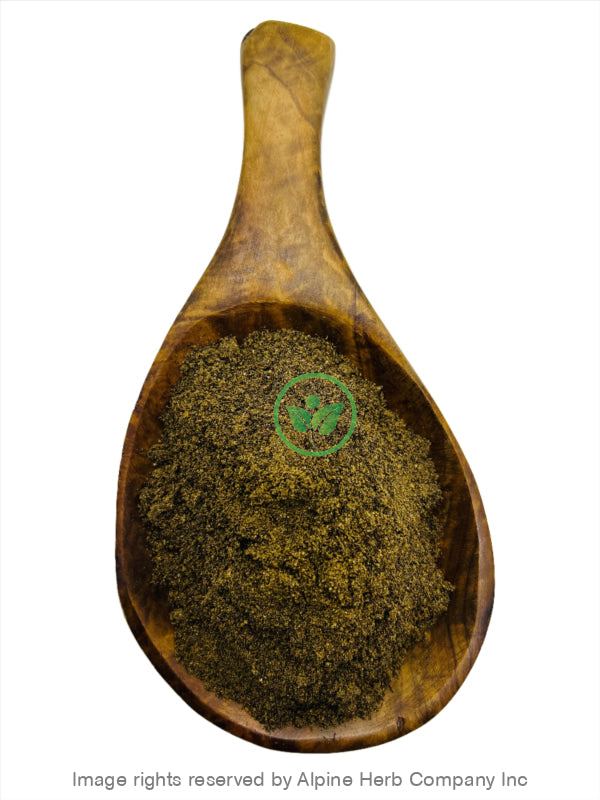Kalijiri Powder Alpine Herb Company Inc.
$ 12,49 $ 7,49
Botanical Name: Centratherum anthelminticum
Common Name:
- English: Purple Flebane, Worm Seed Fleabane
- Ayurvedic: Aranya-Jiraka, Vanajiraka, Kaalijiri, Karjiri. Somaraaji
- Unani: Kamoon barri
-
Also, known as: Aranya jirakah, Brhatpali, Somaraji, Vanajirakah, Somaraaj, Kaaleejeeree, Kadavijeeree, Kaalijeeree, Karajiri, Soharaai, Kaadujeerage, Kaarijirige, Kaadujeerage, Kaarijirige, Kaadujeerage, Kaarijirige, Kashmiri, Krimishatru, Kattujirakam, Kadujire, Kaattuchirakam, Chittilai, Adavijilakaroa, Garetikamma, Kaattu seerakam, Vanda, English: Purple Flebane
Hindi : Kali Jeeri, Kalijiri, Karbi Jiri, Karba Jeera, Kaali Jeeri, Soharaai, Bakshi, Bakchi, and Buckshi
Tamil: Kattuchirakam, Chittilai and Kattu chirakam
Malayalam: Karun Jiragram
Telugu: Adavijilakaroa, Garetikamma
Gujarati: Kaaleejeeree, Kadavijiri, Kadvo-Jviri
Sanskrit: Aryana Jeerak, Tikta Jeerak, Vrihatpali, Kalijeeri, Somaraji, Vanya Jeerak
Bengali: Somaraaj, Babchi
Punjabi: Bukoki, Kakshama, Kala-Zira, Kali-Ziri, Malwabakchi, Malwabakshi
Kannada: Kari Jirige
Origin: India
Harvested: Cultivated
Parts Used: Seed
General Information:
Kalijiri, also termed Bitter Cumin, is the seed obtained from the plant Centratherum Anthelminticum. Kalijiri seeds are traditionally utilized as an ingredient of numerous classical Ayurvedic formulations and are quite popular in combination with Ajwain and Methi for treating obesity and enhancing digestive health. Its powerful antibacterial property makes it useful for the treatment of several skin diseases which helps to reduce itching and skin irritation. Being a powerful blood purifier (correctly detoxifier), Kalijiri eliminates the toxins from the blood and curtails the incidence of different health conditions. Kali Jeeri offers an outstanding remedy for roundworms, tapeworms and threadworms. Although it boosts appetite, its bitter taste may induce nausea in some taste-sensitive people. Kalijiri which goes by the botanical name Centratherum Anthelminticum belongs to the family Asteraceae. It is a tall, branched, glandular-pubescent, annual plant attaining a height of 2-3 feet. The leaves of this plant are membranous, lanceolate, coarsely serrated, and coated with hairs. There are multiple inflorescences which occur in clusters and subcorymbos. The flower head bears 30-40 minute purplish flowers. Fruits of the plant are termed schemes. Each fruit encloses seeds which are blackish-brown to black and tastes bitter. The plant usually bears seeds from May to June.
How to use:
Powdered Herb:
There are different ways to use powdered herb.
Food Preparation: You can add powdered herbs to any super food, herbal smoothie, sauces, spreads and even cookies. Also for children, you can mix powdered herbs with honey or glycerin to make a paste. The thicker the paste, the more potent and herbal in taste. The sweet taste of honey and glycerin will help the medicine go down. This method is also known as “Electuaries”.
Capsules: Encapsulating your own powdered herb at home, give you assurance that the contents of the capsules are pure herb and no filler or any other products. These capsules can be taken with liquid.
Poultice: Poultice can be made with an herbal powder and liquid (mostly water) to form a paste which is then applied to the skin. This method is very helpful for skin conditions.
Herbal shot: Powdered herb can be mixed with water, fruit juice or other liquid to make herbal shot.
Precautions:
You should consult with a qualified healthcare practitioner before using any herbal products, particularly if you are pregnant, nursing, or on any medications.
All information on this website is for educational purposes ONLY.
This information has not been evaluated by Health Canada.
This information is not intended to diagnose, treat, cure, or prevent any disease.
| Unit Size | 100g, 200g, 400g, 1kg |
|---|
Prompt shipping and expert packing
Thanks to our longstanding association with UPS FedEx DHL as well as other leading global carriers, we can offer a variety shipping options. Our warehouse staff is highly trained and will be able to pack your goods in accordance with our precise and exact specifications. Your items will go through an exhaustive examination before they will be securely packaged before being delivered. We ship to hundreds of thousands of customers daily in different countries. This is a sign of our determination to become the largest online retailer worldwide. Warehouses and distribution centers are located throughout Europe as well as in the USA.
Note that orders containing multiple items are processed according to the particular item.
We will thoroughly inspect all items ordered before shipping. Most orders are shipped within 48 hours. The delivery time will be between 3 and 7 working days.
Returns
The stock market is always changing. It's not entirely managed by us since we're involved with several entities, including the factory and the storage. Therefore, the actual inventory could fluctuate at any moment. Please be aware that it is possible that your order could be out of stock after you've placed your order.
Our policy lasts for 30 days. If it's been more than 30 days since the date you purchased your item We're sorry to say that we can't offer you a full exchange or refund.
You can only return a product if it is unused and still in the same state as when you received it. The item should be in the original packaging.
Related products
Herb Powder
Herb Powder
Herb Powder
Herb Powder
Herb Powder
Herb Powder
Herb Powder
Herb Powder
Herb Powder
Herb Powder
Herb Powder
Herb Powder
Herb Powder
Herb Powder
Herb Powder
Herb Powder
Herb Powder
Herb Powder
Herb Powder
Herb Powder


































